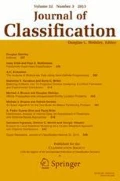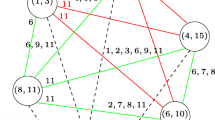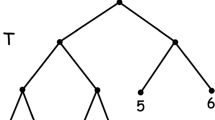Abstract
We show in this paper a bijection between totally balanced hypergraphs and so-called totally balanced dissimilarities. We give an efficient way (O(n3) where n is the number of elements) to (i) recognize if a given dissimilarity is totally balanced and (ii) approximate it if it is not the case. We also introduce a new kind of dissimilarity which generalizes chordal graphs and allows a polynomial number of clusters that can be easily computed and interpreted.


Similar content being viewed by others
References
Anstee, R.P. (1983). Hypergraphs with no special cycles. Combinatorica, 3, 141–146.
Antsee, R.P., & Farber, M. (1984). Characterizations of totally balanced matrices. Journal of Algorithms, 5, 215–230.
Bandelt, H.-J., & Dress, A.W.M. (1989). Weak hierarchies associated with similarity measures – an additive clustering technique. Bulletin of Mathematical Biology, 51, 133–166.
Barthélemy, J.-P., & Brucker, F. (2008). Binary clustering. Journal of Discrete Applied Mathematics, 156, 1237–1250.
Bertrand, P. (2000). Set systems and dissimilarities. European Journal of Combinatorics, 21, 727–743.
Bertrand, P., & Diatta, J. (2014) In Aleskerov, F, Goldengorin, B, Pardalo, P.M. (Eds.), Weak hierarchies: a central clustering structure clusters, orders, and trees: methods and applications. Berlin: Springer. chapter 14.
Brucker, F. (2005). From hypertrees to arboreal quasi-ultrametrics. Discrete Applied Mathematics, 147, 3–26.
Brucker, F., & Gély, A. (2009). Parsimonious cluster systems. Advances in Data Analysis and Classification, 3, 189–204.
Brucker, F., & Gély, A. (2010). Crown-free lattices and their related graphs. Order, 28, 443–454.
Brucker, F., & Préa, P. (2015). Totally balanced formal concept representations. Proceedings of ICFCA, 215, 169–182.
Diatta, J., & Fichet, B. (1994) In Diday, E., Lechevallier, Y., Schader, M., Bertrand, P., Burtschy, B. (Eds.), From Asprejan hierarchies and Bandelt-Dress weak-hierarchies to quasi-hierarchies, new approaches in classification and data analysis, (pp. 111–118). Berlin: Springer.
Dirac, G.A. (1961). On rigid circuit graphs. Abhandlungen aus dem Mathematischen Seminar der Universität Hamburg, 25(1961), 71–76.
Farber, M. (1983). Characterizations of strongly chordal graphs. Discrete Mathematics, 43, 173–189.
Henley, N.M. (1969). A psychological study of the semantics of animal terms. Journal of Verbal Learning and Verbal Behaviour, 8, 176–184.
Lehel, J. (1985). A characterization of totally balanced hypergraphs. Discrete Mathematics, 57, 59–65.
Lovasz, L. (1968). Graphs and set systems, Beiträge zur Graphentheorie H. Sachs, & et al. (Eds.) Teubner, Leipzig.
Lubiw, A. (1987). Doubly lexical orderings of matrices. SIAM Journal on Computing, 16, 854–879.
Sokal, R., & Michener, D. (1968). A statistical method for evaluating systematic relationships. University of Kansas Science Bulletin, 38, 1409–1438.
Spinrad, J. (1993). Doubly lexical ordering of dense 0-1 matrices. Information Processing Letters, 45, 229–235.
Spinrad, J. (2003). Efficient graph representations, American Mathematical Society, 2003.
Author information
Authors and Affiliations
Corresponding author
Additional information
Publisher’s Note
Springer Nature remains neutral with regard to jurisdictional claims in published maps and institutional affiliations.
Rights and permissions
About this article
Cite this article
Brucker, F., Préa, P. & Châtel, C. Totally Balanced Dissimilarities. J Classif 37, 203–222 (2020). https://doi.org/10.1007/s00357-019-09320-w
Published:
Issue Date:
DOI: https://doi.org/10.1007/s00357-019-09320-w




